Crapshoot: The games of variable quality based on Star Trek: The Next Generation
We're rerunning Richard Cobbett's classic Crapshoot column, in which he rolled the dice and took a chance on obscure games—both good and bad
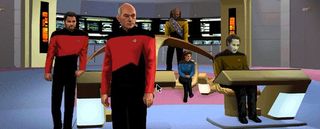
From 2010 to 2014 Richard Cobbett wrote Crapshoot, a column about rolling the dice to bring random obscure games back into the light. Following his look at Star Trek: Judgment Rites, we warp ahead in time to visit The Next Generation for A Final Unity, Generations, and the Q who put the Q in Q.
It's difficult to tell where The Next Generation begins and ends, in terms of PC games. Last week we looked at Judgment Rites, based on the original series, which came out in 1993. The Next Generation, however, had been running since 1987, and ended in 1994. The idiocy that was Star Trek: Voyager then kicked off in 1995. In short, there wasn't much time for Star Trek games to embrace The Next Generation specifically, and most of the games that came out bridged a couple of different eras.
Luckily, I give precisely zero-eighths of a damn about this, and even less about precisely where in-game stardates place individual games or if they mention the likes of the Vidiians. If they're set post-TOS in the Alpha/Beta quadrants and don't involve Deep Space Nine or the Ship of Fools, they count. Rules set, let's dig into the games of The Next Generation—the good, the bad, and the make it so-so.
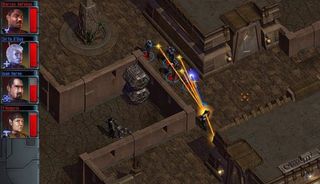
Suffice it to say, there aren't many in the 'good' category—though there are are a few solid ones. The very first 'proper' Next Generation game, lumbered with the awesomely terrible name "The Transinium Challenge" actually preceded Judgment Rites, and... was not one of the good ones.
What stands out most about Next Generation games is that nobody had a bloody clue what they should be. A shooter? An adventure? Something that used the universe, but otherwise avoided the characters? This became especially important for financial reasons. Most Next Gen games were made in the era of CD-ROM, when things like full voiceovers became expected. The cost of hiring and recording a cast made up of beloved celebrities used to getting a billion dollars per autograph is not a small one, to say nothing of having to license their likenesses too—especially as Trekkies/ers would complain.
(This later proved an issue for one Deep Space Nine game, and Jeri Ryan's refusal to play Seven of Nine in the original Elite Force shooter was jarring, if hardly disastrous to Voyager's many deluded fans. I suppose they figured that if they stuck with the show after Threshold, anything went.)

Most Next Generation games therefore spent their money more wisely—perhaps lashing out for Patrick Stewart and a couple of the others, but otherwise focusing on the universe rather than the USS Enterprise NCC-701D itself. There was Star Trek Armada for instance, a real-time space-based strategy game, and Away Team, which took the action down to planets. There was New Worlds, in every way the Force Commander of the Star Trek universe, and Bridge Commander, which did as good a job of simulating capital ship combat as anything before or since. Flawed, yes, but decent. Elsewhere, there were the pointless ones, like Starship Creator and its sequel, or Captain's Chair, a tour of the various Star Trek ships which was notable for who they couldn't rope in to do a quick voiceover. Patrick Stewart? Ha! Good thing Jonathan Frakes was up for a pay-cheque for damn near anything at the time.
The biggest gaming news, reviews and hardware deals
Keep up to date with the most important stories and the best deals, as picked by the PC Gamer team.
And then... there were the weird ones. Klingon Honour Guard for instance, an Unreal-powered okay-I-guess shooter where you got to be one of the pastie-headed goons and be bellowed at about honour a lot, and the much, much sadder Star Trek: Klingon—an interactive movie that taught you Klingon customs.
You knew you were really in the boondocks though when Q showed up. Q of course being John de Lancie's endearingly punchable omnipotent god. There was an early online card game called ConQuest (good job they weren't called the Z, really), another interactive movie I won't spoil just yet, and... I'm sorry to say... Star Trek: The Game Show. Which actually exists and is real. Unfortunately.
By Worf's gold pants, this one is painful—from the music to the video shot in Onlyonepersoncanmoveatonceavision (a common problem in the mid-90s, but one most games avoided by not pretending to have the actors bounce lines off each other when they were clearly filmed in isolation, reading a script written on toilet paper). As the Klingons would say: Experience Bij!
Gah. The horrible, horrible... horribleness! Let's get back to the Enterprise and check in on Picard and co properly, shall we? Things can only get better from here... right? Lie if you have to!
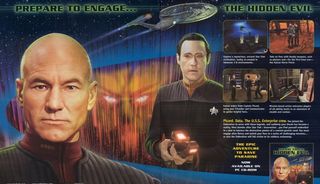
There were four games about the Enterprise crew specifically—the first and most obscure of which was of course The Transinium Challenge in all its non-glory. Second prize in that category goes to Star Trek: Hidden Evil, which was (justifiably) so ashamed to be the official game tie-in to the utterly pointless Insurrection movie that it barely mentions it on the box. It's boring and that's all you need to know.
Luckily, when you've hit bottom, there's only one way to go.
In both the other games—one a movie tie-in, another an independent story—actual effort was made to create something interesting. First up, from 1995, it's A Final Unity, the Next Generation adventure that also wanted to be a next generation adventure, despite quite literally giving the fans A FU.

While it has a pretty good reputation, A Final Unity honestly isn't a very good adventure. It's a not-very-good adventure with its heart firmly in the right place though, and at least part of the trouble can be pinned on The Next Generation itself. I have fond memories of the show, don't get me wrong—particularly sitting on the sofa with my dad when we first got Sky, evening after evening, watching the whole thing from start to finish on the late-night repeats.
Compared to the original series though, it doesn't so much have a stick up its ass as an adamantium-infused rod. Where Kirk was a cowboy, Picard is a diplomat. The original series could shamelessly serve up stuff like sentient time machines and episodes like Spock's Brain. Next Gen had its silly moments, no doubt—it was the series that introduced Q after all—but was much more comfortable waving tricorders at things and saving the day by abusing the words TECH TECH TECH like a smack addict abuses a Golden Ticket to Willy Wonka's secret meth lab. (He built it when he moved on from Charlie.)
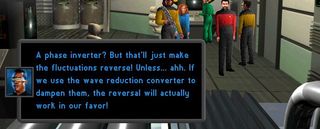
That has a major effect on A Final Unity, which is essentially Judgment Rites/25th Anniversary without the sense of whimsy. Where those games were full of banter, with Kirk taking charge from his trademark power-slouch, the Enterprise D crew spends the entire game bolt-upright and looking serious on the bridge to the point that you almost want the human touch of Riker sneakily scratching his balls while nobody's looking. At the very least, Picard doesn't need to glare at the viewscreen all the time!
As a Next Generation game though, especially before the movies, that shouldn't be a surprise— and A Final Unity does a great job of converting the series. You can go check out the stations. There's spaceship combat. If you're not playing on the lowest difficulty level, you can even choose your Away Team members like you were playing an RPG—something very, very cool at the time. And of course if you get stuck, you benefit from the experience and wisdom of the best crew in Starfleet!
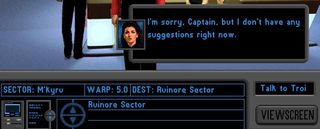
The problems with it are that most of the missions you go on are pretty boring, and incredibly inconsistent. The graphics especially seem to have been done by about twelve different artists who never spoke to each other, bouncing from 3D rendered to almost pastel backgrounds. Puzzles have some interesting elements, like either saving or killing a wounded person depending on what phaser setting you use to cut them free, but are generally much too reliant on stuff like "Use the Flux Router on the Holotable" instead of intuition and intelligence or just shooting stuff. It's so very, very cold, from the lack of banter and music to the clipped voiceover work from a cast that mostly comes across as genuinely not giving a damn about these characters any more. See also: the movies.
That doesn't overwrite the stuff it does well though, especially at the start. You get the actual TNG intro, with "A Final Unity" appearing as if it was an episode title. Unlike many adventures, you're also thrust right into the deep-end, mediating a conflict between a group of political dissidents and the warship sent to retrieve them. If you want, you can sort it out by bringing up the Tactical display and opening fire. You can play it smart, taking Data's advice and blocking the tractor beam with the Enterprise. Or you can try diplomacy, both before and after the initial encounter, as Picard would. It's perfect. It's the Next Generation experience in a nutshell, as good as a mid-90s game really could expect to do it.

Things quickly go downhill with the story though, which is both extremely dull and more than a bit reminiscent of Judgment Rites. It starts out as a hunt for an artefact called The Fifth Scroll, which will hopefully stop a war, only for the search to lead to yet another group of obnoxious-challenge setting space elves called the Chodak, and a mysterious machine they built called the Unity Device. Before long, the Romulans are invading, deadly probes are destroying space stations, and a scientist goes missing on a planet of matriarchal monkeys. Yes, really. It's eventually tied to the main story, but not to the point that it seems like a sane diversion for the flagship of the fleet to go on when anything else is happening in the universe. Hell, I'm not sure it's worth interrupting a holodeck program for.
Even so, described like this, the plot might sound cool. It's really, really not. I would however have forgiven it everything, even the unwinnable situations and lack of stuff to do on most screens, had First Contact with the enigmatic new species at the heart of the story gone like this:
PICARD: On behalf of the United Federation of Planets, I greet you, and express my most sincere hope that this unity we have forged will grow, thrive, and... Mr. Data, are you taking photographs?
DATA: Aye, sir. It's a Chodak moment.
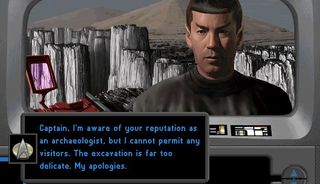
Like with the Brassicans, A Final Unity ends with the Enterprise's Captain and in this case two aliens being put through a series of tests of character and intelligence and pointing and clicking, which conclude with the Unity Device going, in about as many words "Congratulations, the testing is done and you pass with flying colours! In unrelated news: OH HEY LOOK AN INCOMING BORG FLEET THAT I CAN TOTALLY BLOW UP FOR YOU WITH MY POWER SHOULD I BLOW IT UP FOR YOU?"
In the words of Admiral Ackbar: "Dude, seriously?"
By proving himself enough of a diplomat not to reach over and slap it in the face, Picard demonstrates his worthiness to the Unity Device, and is promptly rewarded by said super-machine announcing that it's been fun, but it's quite happy just mending space-rifts on its own. There's a little more to it than that, but the story still ends with it buggering off into spacetime to never, ever be mentioned again in canon. It doesn't even bother waiting for Picard to be picked up—just leaving him floating in space in a little bubble while the Enterprise almost gets destroyed by its departure. Good job it survives, because otherwise the game and series would have ended with him starving to death surrounded by his own poo and screaming that he's been Lear, dammit. Even Kirk got a better send-off than that. Just .
In short, don't do favours for space elves. They're complete dicks.
Unsurprisingly, the Unity Device has precisely zero impact on the Star Trek universe as a whole. The Chodak however did make one other appearance in Star Trek—in our next game, Generations. It was an awful, insultingly stupid movie. What are the odds the game was anything but pure crap?
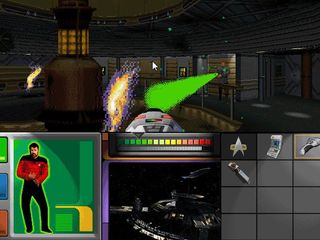
As with A Final Unity, Generations may not hit a home-run, but it gets bonus points for trying. It's a shooter, and one whose technology was badly dated by release, but had some very interesting elements. There's constant narration as you explore the worlds for starters, and a fair amount of interaction with them. Between those away team missions, you get space combat too, and a kind of strategy/RPG very-very-lite system set in the fancy Stellar Cartography suite where you try to track Malcolm McDowell's character, Soran, as he blows up suns to redirect the path of a swirly energy thing he wants to get to, but is too stupid to just steal a ship and fly at. Just like the movie!
With the real story offering essentially no strange new worlds to explore, Generations compensates by having Soran blip around the galaxy like a particularly unimaginative Carmen Sandiego to make new weapons, find fuel for weapons, and occasionally blow up a few suns. Unlike most shooters, you're sometimes allowed to fail missions, which has effects on which missions you go on and in when. Lose a big system though, and Starfleet will just yoink the Enterprise back home, in favour of leaving Soran completely unchallenged? Well, it wouldn't be the stupidest decision they ever made.
There are a few repeated locations, but most are set in completely new environments that take full advantage of not having to make sense—an organic planet is probably the silliest—and the large cast. Everyone gets their turn to show off, from Riker investigating Deep Space Actually In The Film in the first mission to Dr. Crusher, a name I still find disturbing, taking on giant amoeba monsters.
Even Troi gets a turn, in arguably one of the most interesting. It's set in a Romulan base, and she's sent in undercover on the grounds that she was once kidnapped and surgically altered to look like a Romulan and therefore would probably be cool with repeating the traumatic experience. Excessive? No. In the Star Trek universe, anything from gender-switching to passing yourself off as an alien is merely a five-minute job for a good doctor. Really, about the only thing they can't do is get a newly rescued Borg out of a catsuit and into actual clothes in less than a year. Or possibly just "won't". It never was clear.
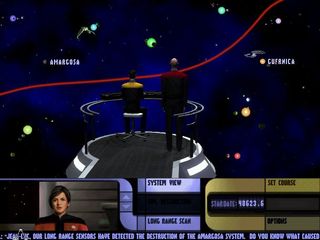
As you can see, Generations has not aged well. It gets definite points for trying though, especially when it could so easily have been something infinitely lazier. If you choose to track down a copy though, be aware that it's a genuine bitch of a game to get running. My copy of Windows 98 on a VMWare virtual machine can play the movies. My copy of Windows 98 on Virtualbox can play the game. Good luck if you want both halves at once—it's a game that really, really wants to be on Windows 95.
Next week, it's off to Deep Space Nine. It's the best Star Trek series ever, but did it have the best games? It definitely had the fewest. Until then, here's Worf being told to shut up for 15 minutes. For bonus points, count how many times he's right. At least eventually, he'd get a little respect...
Most Popular


